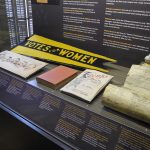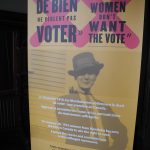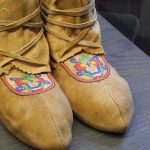By Leah Den Hartogh [6]
BELLEVILLE – One hundred years after women won the right to vote in Ontario, Melissa Wakeling, education and marketing coordinator at the Glanmore National Historic Site [7], believes that there needs to be a third wave in feminism.
“There is tons of things that we can still do to improve women’s rights.”
Some of these issues are equal pay, universal childcare, the number of women in politics and luxury taxes, she said.
The Glanmore is running an exhibit until May 7 called Nice Women Don’t Want the Vote [8] which highlights the first wave of feminism.
“One of the things that I think people will really enjoy is the opportunity to have input … our museum staff empties out the ballot box and adds your comments to the exhibit,” Wakeling said.
Visitors can answer one of three questions:
- I want to vote because?
- If you could say one thing to a suffragist from one hundred years ago what would you say?
- What is one issue facing Canadian women today?
“A lot of the comments have been about the fact that the suffragists didn’t include aboriginal women or women of other ethnicities in their battle. So there are people that have said ‘well thanks for getting us started, but you weren’t very inclusive,” she said.
There are two major figures from the Belleville area that were major parts in the suffragist movements in Ontario and internationally. Mary Richardson [9] was one of these figures.
Richardson led some of the more violent cases and was at one point arrested for her actions in the suffragette movement. She was famously known for destroying a painting [10] of a woman lying naked.
Another figure known in the area for his part in the suffragist movement is J.W. Johnson [11]. He put forth the bill that would give some women the right to vote in Ontario.
The exhibit showcases figures from the Manitoba suffragist movement exclusively.
“I hope they will just think a little bit more about women’s rights and women’s issues because I think a lot of people just assume that there is nothing left to fight for,” she said.
The interactive exhibit displays different artifacts, audio clips, and photographs from key moments from the movement.
One of the artifacts shown in the exhibit is a scroll that is 28 feet long which has names signing a petition to try to give the right to vote to women.
We’ve taken a close up photo of an artifact from the “Nice Women Don’t Want the Vote” exhibit. Can you guess what it is? #BellevilleON [12] pic.twitter.com/hml6QfufnL [13]
— Glanmore NHS (@GlanmoreNHS) March 28, 2017 [14]
The colour scheme of the exhibit is shown in bright colours. The gold is used in the exhibit as a symbol for the suffragists.
The exhibit will be moving back to the prairies after its stay at Glanmore. Glanmore has been the only museum in Ontario that has shown the exhibit yet.
It runs until May 7 at Glanmore, 257 Bridge St. E. in Belleville, Tuesdays through Sundays, 1 to 4:30 p.m.




